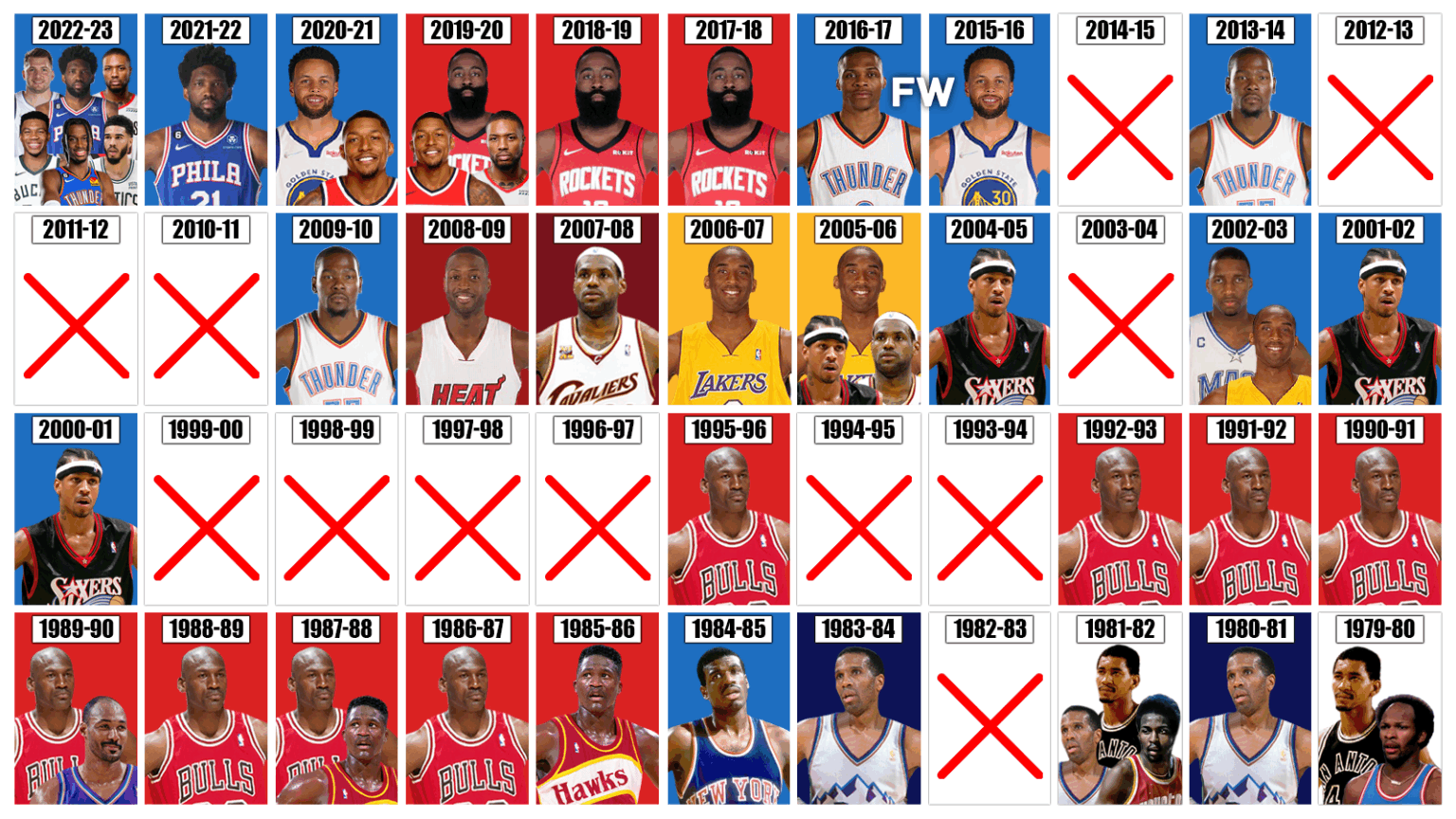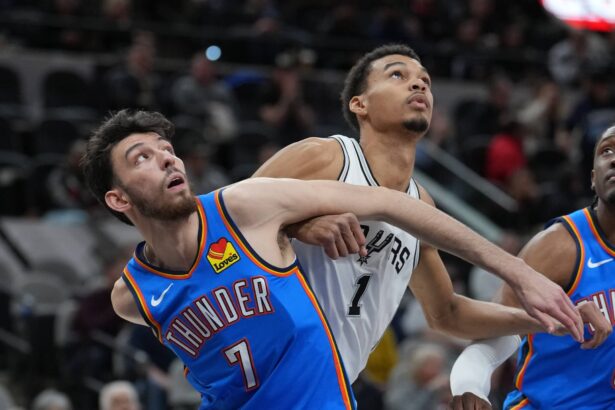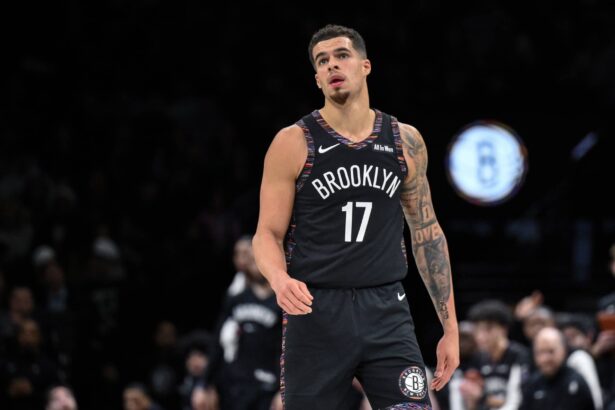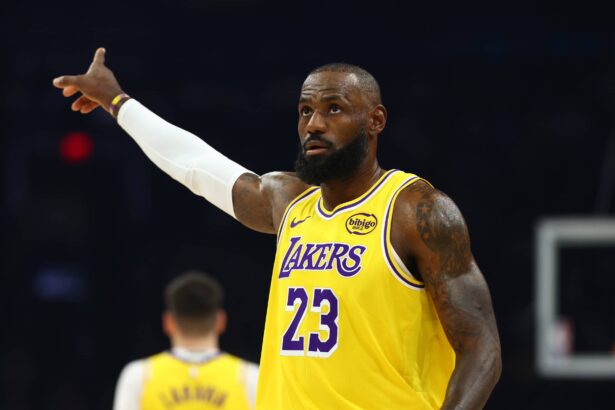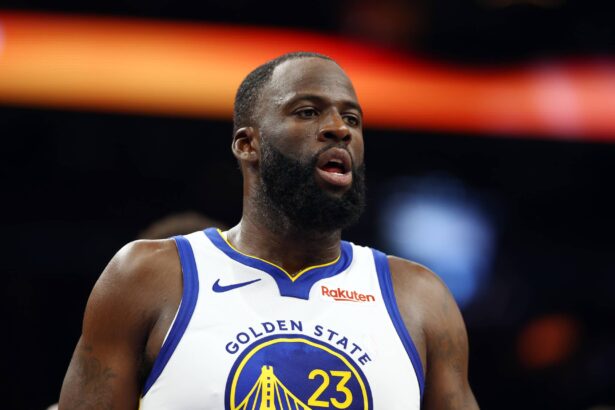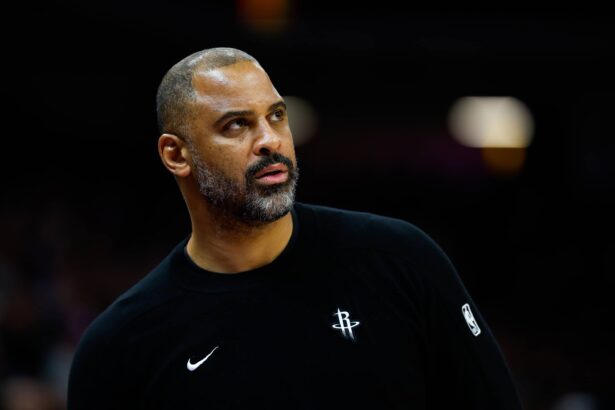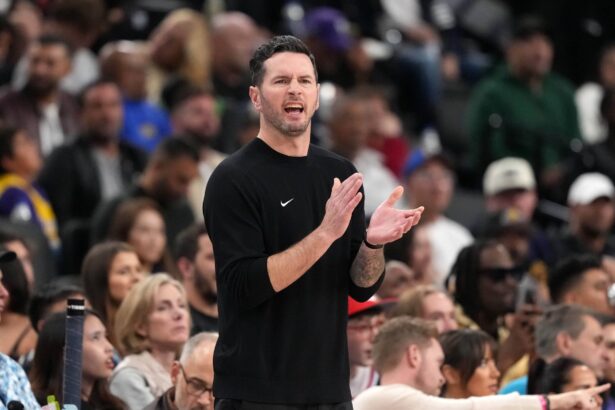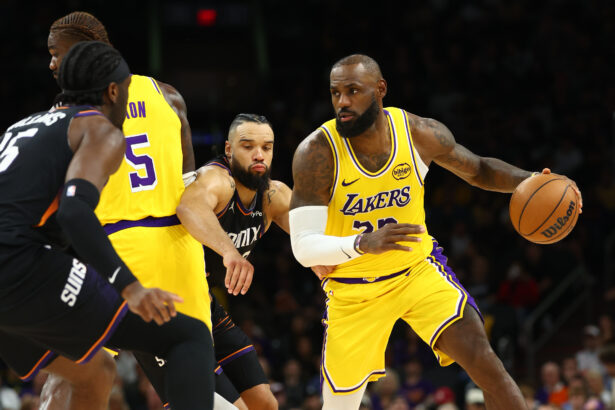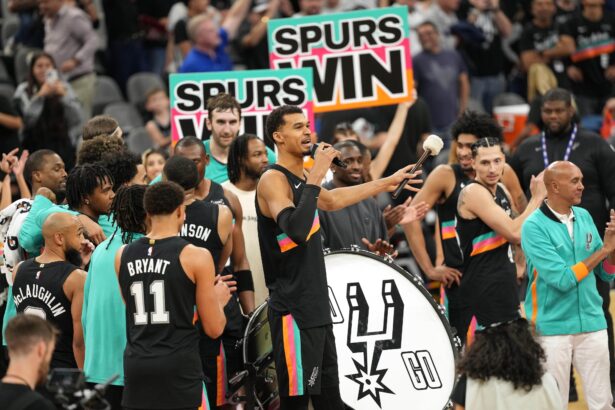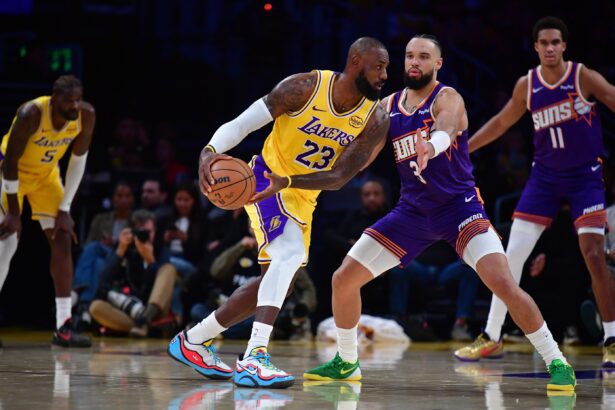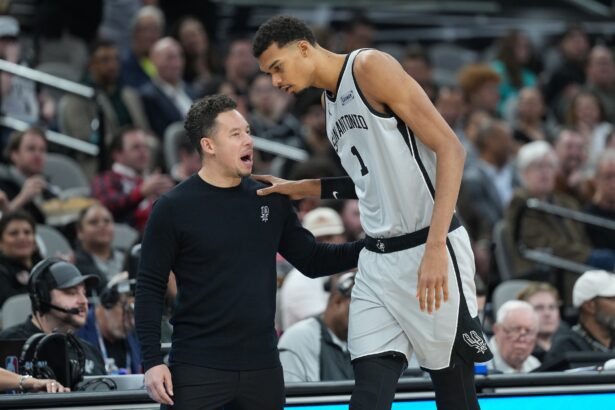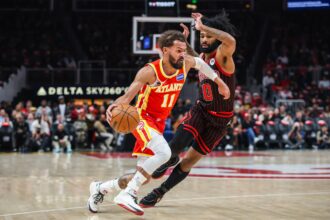- 30-point games are hard to come by in the NBA during any era
- There are some elite scorers who managed to post at least 30 points per game year after year
- The NBA has changed dramatically over the past few seasons, and scoring is easier than ever
The NBA has shifted over the past few decades, welcoming offense more than ever. In fact, rule changes have slowly been implemented to allow for more scoring, which means there are players averaging at least 30 points per game on a consistent basis.
- 1979–80 NBA Season – 2 Players
- 1980–81 NBA Season – 1 Player
- 1981–82 NBA Season – 3 Players
- 1982–83 – 0 Players
- 1983–84 – 1 Player
- 1984–85 – 1 Player
- 1985–86 – 1 Player
- 1986-87 – 1 Player
- 1987-88 – 2 Players
- 1988-89 – 1 Player
- 1989-90 – 2 Players
- 1990-91 – 1 Player
- 1991-92 – 1 Player
- 1992-93 – 1 Player
- 1993-94 – 0 Players
- 1994-95 – 0 Players
- 1995-96 – 1 Player
- 1996-97 – 0 Players
- 1997-98 – 0 Players
- 1998-99 – 0 Players
- 1999-00 – 0 Players
- 2000-01 – 1 Player
- 2001-02 – 1 Player
- 2002-03 – 2 Players
- 2003-04 – 0 Players
- 2004-05 – 1 Player
- 2005-06 – 3 Players
- 2006-07 – 1 Player
- 2007-08 – 1 Player
- 2008-09 – 1 Player
- 2009-10 – 1 Player
- 2010-11 – 0 Players
- 2011-12 – 0 Players
- 2012-13 – 0 Players
- 2013-14 – 1 Player
- 2014-15 – 0 Players
- 2015-16 – 1 Player
- 2016-17 – 1 Player
- 2017-18 – 1 Player
- 2018-19 – 1 Player
- 2019-20 – 3 Players
- 2020-21 – 2 Players
- 2021-22 – 1 Player
- 2022-23 – 6 Players
In almost every season, there is usually a player who comes close to posting 30 points per game or actually accomplishes it.
While it is a testament to the spectacular play of elite NBA scorers, it is also due to the paradigm shift towards the offensive side of the floor.
Remember, offense sells tickets and improves ratings, even if defense does indeed prove to be the difference when it comes to winning championships.
These rule changes include the banning of hand-checking in 1979 and including the three-point line in the 1980 season. By 1995, the hand-checking rule was further enforced, and that meant stars such as Michael Jordan and others could dominate on offense.
By 2005, hand-checking was basically eradicated entirely and that gave players such as Kobe Bryant a chance to go off on offense (81-point game). By 2020, we saw an entirely different phenomenon whereby even the slightest contact resulted in fouls, and that meant All-Star offensive players could become superstars just like that.
More so than ever, scoring 30 points per game is easiest for NBA stars and it is time to go through history from 1980 until 2023 for the players who averaged at least 30 points per game.
1979–80 NBA Season – 2 Players
1. George Gervin – 33.1 PPG
2. World B. Free – 30.2 PPG
In the dynamic landscape of the 1980 NBA season, two standout players emerged as scoring juggernauts. George Gervin, often referred to as “The Iceman,” showcased his unparalleled finesse on the court, leading the league with an astonishing average of 33.1 points per game.
Gervin’s scoring arsenal was a blend of elegance and efficiency, his mid-range jumpers and signature finger roll shots becoming emblematic of his playstyle.
His remarkable skill to score from virtually anywhere on the court made him a perennial threat, and his impact extended beyond the scoreboard, creating openings for his teammates as he shot 52.8% from the field.
Meanwhile, World B. Free brought his own brand of showmanship to the game, lighting up the court with an average of 30.2 points per game. His flamboyant playing style and captivating personality added an entertaining dimension to his performances.
Free’s versatility as a scorer was a cornerstone of the Golden State Warriors’ offensive strategy, whether he was sinking deep shots or dazzling with his acrobatic finishes around the rim.
1980–81 NBA Season – 1 Player
Adrian Dantley – 30.6 PPG
In 1981, one player stood out as a scoring force to be reckoned with. Adrian Dantley, with his average of 30.6 points per game, showcased an exceptional dominance to put the ball in the basket.
Dantley’s offensive prowess was built on a foundation of skill and finesse, as he displayed a remarkable knack for getting to the free-throw line (9.8 attempts per game) and converting his opportunities with consistency (80.6%).
His low-post moves and mid-range jump shots were executed with surgical precision, making him a challenging matchup for defenders.
Dantley’s scoring wasn’t just about quantity; it was about his efficiency and intelligent shot selection. His impact on the Utah Jazz’s offensive strategy was profound, often serving as the linchpin around which their scoring efforts revolved.
1981–82 NBA Season – 3 Players
1. George Gervin 32.3 PPG
2. Moses Malone 31.1 PPG
3. Adrian Dantley 30.3 PPG
The 1982 NBA season witnessed a trio of remarkable scorers who dominated the hardwood with their exceptional point production. At the forefront was George Gervin, a consistent force on offense, who continued to shine with an average of 32.3 points per game.
Gervin’s smooth shooting and unparalleled IQ to find scoring opportunities made him a perennial threat, and his influence extended beyond the box score, elevating his team’s offensive dynamics.
Moses Malone, with an average of 31.1 points per game, showcased his dominance in the paint. His physicality, rebounding prowess (14.7 rebounds per game), and tenacity around the rim combined to create an offensive powerhouse.
Malone’s offensive rebounding, coupled with his finishing skills, allowed him to capitalize on second-chance points and establish himself as a force to be reckoned with on the interior.
Adrian Dantley, contributing 30.3 points per game, epitomized finesse and precision in his scoring approach. Dantley’s mastery of footwork and craftiness around the basket rendered him a formidable offensive weapon.
1982–83 – 0 Players
In the 1982-83 season, no players averaged 30 points per game although Alex English came close with a 28.4 points per game average while shooting 51.6% from the field as a member of the Denver Nuggets.
1983–84 – 1 Player
Adrian Dantley – 30.6 PPG
Once again, Adrian Dantley emerged as a beacon of scoring brilliance. With an average of 30.6 points per game, Dantley once again showcased his uncanny desire to put points on the board with finesse and precision. His offensive repertoire, built upon a foundation of footwork, crafty moves, and a knack for drawing fouls, solidified him as one of the most efficient scorers of his time.
Beyond the impressive point total, Dantley’s tendency to maintain his scoring efficiency was noteworthy. His commitment to high-percentage shots (55.8% from the field) and proficiency at the free-throw line (85.9% on 12.0 attempts per game) showcased his intelligent approach to offense.
1984–85 – 1 Player
Bernard King – 32.9 PPG
During the 1984-85 NBA season, Bernard King showcased an exceptional scoring display, averaging 32.9 points per game. What makes this feat even more remarkable is that he accomplished it with impressive shooting efficiency.
King boasted a field goal percentage of around 53.0%, indicating his desire to convert a significant portion of his shot attempts into points.
Additionally, King’s proficiency extended to the free-throw line. He had a free-throw shooting percentage of approximately 77.2%.
This accuracy from the charity stripe added to his scoring totals, as he was reliable in converting free points whenever he was fouled. The franchise player for the Knicks, King was one of the best scorers in the 1980s.
1985–86 – 1 Player
Dominique Wilkins – 30.3 PPG
In the 1985-86 NBA season, Dominique Wilkins showcased his incredible scoring by averaging 30.3 points per game. Known as “The Human Highlight Film,” Wilkins captivated audiences with his electrifying dunks and versatile offensive game.
Wilkins’ scoring prowess extended to his shooting efficiency. He maintained a field goal percentage of approximately 46.8%, demonstrating his ability to convert shots from various parts of the court.
In addition to his field goal proficiency, Wilkins was a consistent performer at the free-throw line. He had a free-throw shooting percentage of around 81.8%, indicating his skill to capitalize on free points and his composure under pressure situations, even if he never really needed the three-point shot.
1986-87 – 1 Player
Michael Jordan – 37.1 PPG
In the 1986-87 NBA season, Michael Jordan delivered an extraordinary display of scoring prowess, averaging a staggering 37.1 points per game. Jordan’s scoring was characterized not only by its volume but also by its incredible efficiency.
He maintained a field goal percentage of approximately 48.2%, showcasing his ability to convert shots from a variety of positions on the court.
This efficiency was particularly impressive, given the defensive attention he consistently faced. At the free-throw line, Jordan continued to excel.
He boasted a free-throw shooting percentage of around 85.7%, highlighting his proficiency in capitalizing on scoring opportunities even when the clock was stopped. Scoring title number one was in the books for the 23-year-old.
1987-88 – 2 Players
1. Michael Jordan – 35.0 PPG
2. Dominique Wilkins – 30.7 PPG
Scoring title number two appeared in Michael Jordan’s resume following the 1987-88 season. The 1987-88 NBA season witnessed an extraordinary duel in scoring supremacy between two iconic players.
At the forefront was Michael Jordan, whose transcendent abilities on the court were once again on full display as he averaged an impressive 35.0 points per game. Jordan’s scoring mastery was a spectacle to behold, as he continued to redefine what was possible on offense.
Jordan’s scoring prowess was not just about putting up points in high volume; it was about his incredible efficiency. He maintained a field goal percentage of approximately 53.5%, a testament to his greatness at converting a wide array of shots with remarkable accuracy.
His versatility in scoring, whether through mid-range jumpers, powerful drives, or gravity-defying dunks, made him a matchup nightmare for opponents.
On the other end of the court, Dominique Wilkins also commanded attention with his scoring brilliance. Averaging 30.7 points per game, Wilkins showcased the electrifying style that made him an unstoppable force.
His explosive athleticism and shot-creation from virtually anywhere on the court solidified his status as one of the premier scorers of his era.
1988-89 – 1 Player
Michael Jordan – 32.5 PPG
In the 1988-89 NBA season, Michael Jordan continued his legacy of excellence by averaging 32.5 points per game. While slightly lower than some of his other remarkable scoring seasons, Jordan’s scoring output still remained at an elite level, showcasing his consistency as one of the premier offensive forces in the league as he won his third straight scoring title.
Even with a slightly lower scoring average, Jordan’s efficiency remained impressive. He maintained a field goal percentage of approximately 53.8%, emphasizing his dominance to convert shots at a high rate while often facing double teams and defensive attention. He wouldn’t be done just yet.
1989-90 – 2 Players
1. Michael Jordan – 33.6 PPG
2. Karl Malone – 31.0 PPG
Two incredible superstars went head-to-head for the scoring title, but there was always going to be one winner: the three-time scoring champion. At the forefront again was Michael Jordan, who continued to redefine greatness by averaging an outstanding 33.6 points per game while shooting 52.6%, underlining his efficiency as a scorer.
Joining Jordan at the top was Karl Malone, whose imposing presence and offensive prowess earned him the nickname “The Mailman.” Averaging 31.0 points per game in the same season, Malone showcased his dominance in the paint on offense. As tight as this scoring race seemed, Jordan was always going to win his fourth straight scoring title.
1990-91 – 1 Player
Michael Jordan – 31.5 PPG
Michael Jordan continued his scoring dominance, posting 31.5 points per game. This time, however, his production meant something as the Chicago Bulls went on to win their first NBA championship.
While averaging over 30 again, he maintained a field goal percentage of approximately 53.9%, indicating his efficiency in converting shots even while facing strong defensive attention.
His scoring wasn’t just about putting up points; it was about making his team better, influencing their success, and stepping up in crucial moments. His leadership on and off the court was instrumental in guiding the Bulls to their historic triumph.
1991-92 – 1 Player
Michael Jordan – 30.1 PPG
With Jordan again the only player to post at least 30 points per game and captured his sixth scoring title in a row, the shooting guard was simply the greatest ever at this point.
Beyond the numbers, Jordan’s impact on the game was far-reaching. He continued to lead the Chicago Bulls both on and off the court, setting an example of excellence and work ethic for his teammates.
His scoring wasn’t just about individual achievement; it was about elevating the collective performance of the team and pursuing championship glory.
The 1991-92 season was significant as it marked Jordan’s second NBA championship with the Bulls. Michael Jordan’s average of 30.1 points per game solidified his status as a generational talent and a player capable of consistently impacting the game at the highest level.
1992-93 – 1 Player
Michael Jordan – 32.6 PPG
In the season in which Jordan completed his three-peat, the player managed another season averaging at least 30 points per game and managed to capture his seventh straight scoring title. Simply remarkable stuff from the greatest player of all time.
In the 1992-93 NBA season, Michael Jordan continued his incredible legacy by once again showcasing his unmatched scoring prowess, averaging an impressive 32.6 points per game. This season marked another chapter in Jordan’s storied career and emphasized his enduring impact on the game of basketball.
1993-94 – 0 Players
With Michael Jordan retired and out of the game, there wasn’t a single player who could average at least 30 points per game as the closest was David Robinson who averaged 29.8 points per game for the San Antonio Spurs. The race for the best player in the world came between Robinson and NBA champion Hakeem Olajuwon during this time.
1994-95 – 0 Players
With Jordan out of the league again, returning for only 17 games, no player could average at least 30 again, although superstar center Shaquille O’Neal managed a more than impressive 29.3 points per game on 58.3% from the field. No worries, as Michael Jordan would return back on top the following season.
1995-96 – 1 Player
Michael Jordan – 30.4 PPG
With his retirement out of the way, Jordan was back in business, winning his fourth championship and leading the league in scoring yet again for his 7th scoring title. His scoring prowess remained undiminished, as he averaged 30.4 points per game. This season marked a remarkable chapter in Jordan’s career and a triumphant return to the game he had dominated for so long.
Even with the brief hiatus, he maintained a field goal percentage of approximately 49.5%, and Jordan’s presence on the court was a driving force for the Chicago Bulls. His leadership, clutch performances, and unmatched work ethic propelled the team to a historic 72-win season and an NBA championship.
1996-97 – 0 Players
Michael Jordan would win his ninth scoring title, except this time he did not even need to post at least 30 points per game. The GOAT posted 29.6 points per game on 48.6% from the field, 37.4% from three, and 83.3% from the free-throw line as he led the Bulls to their fifth NBA championship.
1997-98 – 0 Players
Nobody averaged at least 30 points per game again, even if Jordan won his 10th scoring title by averaging 28.7 points per game on 46.5% from the field and only 23.8% from three. Michael’s efficiency was down, but he still led the Bulls to the completion of a second three-peat, which solidified his GOAT status forever.
1998-99 – 0 Players
Michael Jordan retired for the second time, and it was time for the rise of superstar offensive player Allen Iverson who would win his first scoring title by posting 26.8 points per game. Still, Michael made it seem so normal to average 30 points per game.
1999-00 – 0 Players
Once again, no player managed to average 30 points per game. The closest was superstar Shaquille O’Neal, who managed to win his second scoring title by averaging 29.7 points per game on 57.4% from the field. He didn’t average 30, but at least Shaq won a championship and Finals MVP award.
2000-01 – 1 Player
Allen Iverson – 31.1 PPG
Allen Iverson won his second scoring title in his MVP campaign in 2000-01. This season marked a high point in Iverson’s career and solidified his reputation as one of the most electrifying and prolific scorers in the league.
Iverson’s scoring style was defined by his fearless drives to the basket, lightning-quick crossovers, and shot creation. Standing at just 6 feet tall, he defied expectations with his skill to finish among the trees and score against much taller defenders.
His scoring average of 31.1 points per game highlighted his tendency to carry a significant offensive load for his team, the Philadelphia 76ers.
Beyond the scoring numbers, Iverson’s impact was felt across the league. He was a player who could single-handedly change the course of a game through his scoring bursts, and it showed when he made the NBA Finals.
2001-02 – 1 Player
Allen Iverson – 31.4 PPG
Scoring title number three was in the books for the superstar little man. In the 2001-02 NBA season, Allen Iverson continued to captivate audiences with his electrifying scoring, averaging 31.4 points per game. This season marked another showcase of Iverson’s unique style and his status as one of the league’s premier offensive forces.
Iverson’s scoring in the 2001-02 season mirrored his signature playing style—explosive drives, acrobatic finishes, and a relentless determination to put the ball in the basket. His scoring average of 31.4 points per game emphasized his willingness to take on defenders and create scoring opportunities from virtually anywhere on the court.
2002-03 – 2 Players
1. Tracy McGrady – 32.1 PPG
2. Kobe Bryant 30.0 PPG
The 2002-03 NBA season showcased an extraordinary pairing of two exceptional scorers who left an indelible mark on the league. Leading the charge was Tracy McGrady, who displayed his incredible scoring, averaging an impressive 32.1 points per game. McGrady’s blend of size, skill, and versatility made him a scoring force to be reckoned with.
McGrady’s scoring style was characterized by his smooth shooting stroke, willingness to attack the rim, and capacity to score from all areas of the court. His average of 32.1 points per game underscored his desire to carry a significant offensive load for his team, the Orlando Magic. His performances often featured breathtaking displays of athleticism and a knack for taking over games.
Alongside McGrady was Kobe Bryant, who showcased his own scoring brilliance by averaging 30.0 points per game. Bryant’s scoring arsenal was marked by his footwork, mid-range jumper, and incredible work ethic. His shot creation and skill of excelling in one-on-one situations made him one of the most formidable scorers of his generation.
2003-04 – 0 Players
No players averaged at least 30 points per game in the 2003-04 campaign as the closest was Tracy McGrady who averaged 28.0 points per game as he began to make a case for being the best shooting guard and offensive player in the world with the Orlando Magic.
2004-05 – 1 Player
Allen Iverson – 30.7 PPG
Rule changes at the end of the 2005 season made scoring easier, and the defensive three-second rule weakened defenses big time. While that does not take away from Allen Iverson’s incredible season as he won four scoring titles, it did help the miniature guard.
In the 2004-05 NBA season, Allen Iverson continued to demonstrate his scoring prowess by averaging 30.7 points per game. Iverson’s ability to consistently put points on the board was a testament to his unique playing style and his impact on the game.
Iverson’s scoring in the 2004-05 season echoed his signature approach—quick crossovers, explosive drives to the rim, and a relentless determination to lead his team in scoring. His average of 30.7 points per game emphasized his ability to take on defenders and create scoring opportunities, often against the odds.
2005-06 – 3 Players
1. Kobe Bryant – 35.4 PPG
2. Allen Iverson – 33.0 PPG
3. LeBron James – 31.4 PPG
The 2005-06 NBA season witnessed an incredible trio of players who dominated the league with their scoring prowess. At the forefront was Kobe Bryant, who delivered an astounding average of 35.4 points per game. With an 81-point game, Bryant was on top of the offensive world, so to say.
Following closely was Allen Iverson, averaging 33.0 points per game. Iverson’s fearless drives, quick crossovers, and skill to carry an offensive load for his team were on full display. His scoring average emphasized his desire to create opportunities and convert difficult shots while facing intense defensive attention.
LeBron James rounded out this trio with an impressive average of 31.4 points per game. Known for his combination of size, athleticism, and basketball IQ, James showcased his scoring versatility by attacking the rim, hitting mid-range shots, and even improving his outside shooting.
2006-07 – 1 Player
Kobe Bryant – 31.6 PPG
In the 2006-07 NBA season, Kobe Bryant continued to assert his dominance as one of the league’s premier scorers, averaging 31.6 points per game. Bryant’s performances during this season underscored his scoring prowess and his ability to consistently produce at an elite level.
Bryant’s scoring style remained a spectacle of skill, footwork, and determination. His arsenal of moves allowed him to score from all areas of the court, whether it was his signature fadeaway jump shot, drives to the basket, or his skill to hit shots in clutch moments.
His average of 31.6 points per game highlighted his success in carrying a significant offensive load for the Los Angeles Lakers.
2007-08 – 1 Player
LeBron James – 30.0 PPG
In the 2007-08 NBA season, LeBron James showcased his exceptional scoring by averaging 30.0 points per game. This season marked a significant milestone in James’ career, as he continued to solidify his status as one of the league’s premier offensive forces.
James’ scoring in the 2007-08 season highlighted his versatility and basketball IQ. Known for his combination of size, athleticism, and playmaking skills, he showcased his ability to score from various areas on the court. His average of 30.0 points per game underscored his capability to take on the scoring load for his team, the Cleveland Cavaliers.
2008-09 – 1 Player
Dwyane Wade – 30.2 PPG
In the 2008-09 NBA season, Dwyane Wade showcased his exceptional scoring by averaging 30.2 points per game. Wade’s scoring in the 2008-09 season exemplified his explosive athleticism, creativity, and ability to take over games.
His average of 30.2 points per game underscored his capacity to carry a significant offensive load for his team, the Miami Heat. Known for his obsession with driving to the rim, hitting mid-range shots, and drawing fouls, Wade’s offensive repertoire was a challenge for any defense to contain. As a slasher primarily, Wade shot an incredible 49.1% from the field.
2009-10 – 1 Player
Kevin Durant – 30.1 PPG
In the 2009-10 NBA season, Kevin Durant showcased his exceptional scoring by averaging 30.1 points per game. This season marked a significant step in Durant’s ascent to becoming one of the league’s most prolific scorers.
Durant’s scoring in the 2009-10 season highlighted his remarkable combination of height, shooting skill, and versatility. His ability to score from long range, drive to the basket, and excel in isolation situations made him a matchup nightmare for defenders.
His average of 30.1 points per game emphasized his capability to consistently put points on the board for the Oklahoma City Thunder.
2010-11 – 0 Players
No players averaged at least 30 points per game, although Kevin Durant won his second straight scoring title by posting 27.7 points per game on 46.2% from the field, 35.0% from three, and 88.0% from the free-throw line. A dominant offensive player, Durant let the game come to him rather than forcing the issue.
2011-12 – 0 Players
Durant won his third straight scoring title, averaging 28.0 points per game on 49.6% from the field, 38.7% from three, and 86.0% from the free-throw line. Despite not forcing the issue again, the superstar forward was the best offensive player in the world even when the likes of Kobe Bryant and LeBron James were still in the league.
2012-13 – 0 Players
In 2013, no players averaged at least 30 points per game but the scoring title went to Carmelo Anthony (28.7 points per game) ahead of Kevin Durant (28.1 points per game) and Kobe Bryant (27.3 points per game). Carmelo is one of the game’s best offensive talents to have ever played, and he had an iconic season in 2013.
2013-14 – 1 Player
Kevin Durant – 32.0 PPG
Kevin Durant won his fourth scoring title in the 2014 season, posting 32.0 points per game on 50.3% from the field, 39.1% from three, and 87.3% from the free-throw line. This season marked a pinnacle moment in Durant’s career because he officially solidified his reputation as one of the premier offensive forces of all time.
The 2013-14 season was a defining moment for Kevin Durant, as he not only claimed the scoring title but also earned the NBA Most Valuable Player (MVP) award. His performances during this season solidified his legacy as one of the most dominant scorers of his era and one of the greatest players in the history of the game.
2014-15 – 0 Players
In the 2014-15 season, no players averaged at least 30.0 points per game, although it was the season of Russell Westbrook in an offensive sense. Westbrook was an interesting player at the time because he was a score-first point guard, and he managed to post 28.1 points per game on 42.6% from the field during Durant’s extended time out due to injury.
2015-16 – 1 Player
Stephen Curry – 30.1 PPG
In the 2015-16 NBA season, Stephen Curry elevated his scoring to new heights, averaging an impressive 30.1 points per game. This season marked a historic chapter in Curry’s career as he solidified his status as one of the greatest shooters and scorers the league has ever seen.
Curry’s scoring in the 2015-16 season was characterized by his unparalleled shooting range and incredible accuracy from beyond the arc.
His skill to hit three-pointers (45.4%) from seemingly anywhere on the court revolutionized the game and created new challenges for defenses.
His performances captured the imagination of fans worldwide, and his dynamic style of play redefined how teams approached offense. His leadership, combined with his scoring, propelled the Warriors to a historic 73-win season.
2016-17 – 1 Player
Russell Westbrook – 31.6 PPG
In the 2016-17 NBA season, Russell Westbrook delivered a historic performance by averaging an incredible 31.6 points per game. This season marked a standout chapter in Westbrook’s career, where he not only showcased his scoring prowess but also achieved a remarkable feat by becoming only the second player in NBA history to average a triple-double for the entire season.
Westbrook’s scoring in the 2016-17 season was a blend of explosiveness, athleticism, and determination. His skill to attack the rim, finish through contact, and create scoring opportunities for himself highlighted his dynamic offensive game.
His average of 31.6 points per game underscored his capacity to carry a significant offensive load for the Oklahoma City Thunder, with Kevin Durant departing in free agency.
2017-18 – 1 Player
James Harden – 30.4 PPG
In the 2017-18 NBA season, James Harden demonstrated his exceptional scoring by averaging 30.4 points per game. The season was a pivotal moment for James Harden, as he captured the MVP award for his remarkable scoring and all-around contributions. His performances during this season solidified his legacy as one of the most dynamic scorers and playmakers in the league.
Harden’s scoring in the 2017-18 season showcased his unique blend of skill, craftiness, and tendency to draw fouls. His step-back three-pointers, scoring in isolation, and clever ball-handling made him a matchup nightmare for defenders.
His average of 30.4 points per game emphasized his capability to carry a significant offensive load for the Houston Rockets as the team made the Western Conference Finals at the end of the year.
2018-19 – 1 Player
James Harden – 36.1 PPG
James Harden was at his peak between 2018 and 2020, and his best scoring campaign came in the 2019 campaign as the most unstoppable offensive player we have seen since the prime of Michael Jordan or Kobe Bryant.
In the 2018-19 NBA season, James Harden reached new heights in his scoring prowess by averaging an incredible 36.1 points per game. This season marked a historic chapter in Harden’s career as he achieved one of the highest scoring averages in recent memory.
Harden’s scoring in the 2018-19 season was characterized by his exceptional offensive skill set, including his step-back three-pointers, crafty ball-handling, and tendency to draw fouls.
His scoring arsenal allowed him to take over games and put points on the board in a variety of ways as he was double-teamed from the moment he stepped past half-court. Even if Harden has declined now, his past dominance will never be forgotten.
2019-20 – 3 Players
1. James Harden – 34.3 PPG
2. Bradley Beal – 30.5 PPG
3. Damian Lillard – 30.0 PPG
The 2019-20 season truly marked the shift to pure offense around the world more than ever before in terms of defensive resistance. More so than in any other season, offensive players could do whatever they wanted with fouls called with the slightest contact.
Regardless, three stars stood on top of the scoring mountain in terms of 30 points per game averages. The first was James Harden, continuing his scoring dominance with an average of 34.3 points per game.
Harden’s ability to create scoring opportunities from various positions on the court, his proficiency in isolation situations, and his knack for drawing fouls made him a scoring force to be reckoned with as he won his third straight scoring title.
Bradley Beal followed closely with an average of 30.5 points per game. Beal’s scoring prowess was characterized by his smooth shooting stroke, versatility in scoring from different areas of the court, and his willingness to take on the scoring responsibility for the Washington Wizards.
Damian Lillard rounded out the trio with an average of 30.0 points per game. Lillard’s natural skill to hit deep three-pointers, his clutch performances, and his penchant for scoring in crucial moments made him one of the most feared scorers in the league.
2020-21 – 2 Players
1. Stephen Curry – 32.0 PPG
2. Bradley Beal – 31.3 PPG
The 2020-21 NBA season featured two standout players who exhibited exceptional scoring and left a significant impact on the league.
Stephen Curry continued to showcase his incredible scoring prowess, averaging 32.0 points per game. Curry’s unique skill set, including his unparalleled shooting range and off-ball movement, revolutionized the game of basketball.
His natural skill to hit shots from well beyond the three-point line and his proficiency in creating his own shot made him a scoring force that opposing defenses struggled to contain. During the campaign, Curry shot 42.1% from three.
Bradley Beal followed closely with an average of 31.3 points per game. Beal’s scoring versatility, combined with his skill to score from all areas of the court and his knack for getting to the free-throw line, marked him as one of the league’s premier offensive talents.
Despite playing for a team that faced challenges, Beal’s individual scoring performances stood out even if the Washington Wizards were not going to win anything in the playoffs.
2021-22 – 1 Player
Joel Embiid – 30.6 PPG
In the 2021-22 NBA season, Joel Embiid exhibited his exceptional scoring by averaging 30.6 points per game. The big man’s scoring in the 2021-22 season showcased his combination of size, skill, and finesse.
His skill to score in the post, face up against defenders, and even extend his range to the three-point line made him a difficult matchup for opponents. His average of 30.6 points per game underscored his capacity to carry a significant offensive load for the Philadelphia 76ers.
Beyond the numbers, Embiid’s impact on the game extended to his defensive presence and leadership on the court. He anchored the defense while also being a go-to option on offense made him a cornerstone of his team’s success, because who else could post over 30 points per game on 49.9% shooting from the field, 37.1% from three, and 81.4% from the line as a two-way center?
2022-23 – 6 Players
1. Joel Embiid – 33.1 PPG
2. Luka Doncic – 32.4 PPG
3. Damian Lillard – 32.2 PPG
4. Shai Gilgeous-Alexander – 31.4 PPG
5. Giannis Antetokounmpo – 31.1 PPG
6. Jayson Tatum – 30.1 PPG
Is there any more evidence that offense is at the forefront of the NBA rather than defense when looking at the six players who posted at least 30 points per game? While one can argue that players today are more skilled than ever before, does that mean the likes of Shai Gilgeous-Alexander, Giannis Antetokounmpo, and Jayson Tatum are better offensively than legends of the past? Most likely not.
The league’s MVP won his second straight scoring title as he begins to build his future Hall of Fame resume. An MVP award, two scoring titles, and six All-Star Team selections look strong on Embiid’s list of accolades and his scoring was truly off the charts all year.
Luka Doncic followed closely with an average of 32.4 points per game. Doncic’s versatility, court vision, and scoring at a young age solidified his reputation as one of the most exciting and skilled players in the league at only 24 years old despite having Kyrie Irving beside him for 20 games.
Damian Lillard’s average of 32.2 points per game showcased his long-range shooting and clutch scoring. Lillard’s ability to hit deep three-pointers and his fearless approach in crucial moments continued to make him a standout offensive player even if the Portland Trail Blazers only won 33 games and missed the playoffs.
Shai Gilgeous-Alexander’s emergence as a scorer was evident in his average of 31.4 points per game. His improved scoring efficiency to create for himself marked him as a rising star in the league, as he made his first All-NBA Team.
The Greek Freak still does not have a scoring title to his name, but he did average 31.1 points per game highlighting his unique combination of size, athleticism, and driving. Giannis Antetokounmpo’s versatility and determination to attack the rim made him a scoring force for the Milwaukee Bucks all year long, as this was his career-high mark.
Jayson Tatum rounded out the group with an average of 30.1 points per game. Tatum’s scoring versatility to excel in isolation situations showcased his importance as a primary offensive option for the Boston Celtics as the team made the Eastern Conference Finals due to its solid 57-25 record.

